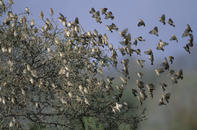Avian influenza, also known as bird flu, has turned into one of the world’s greatest disease threats. The disease not only causes huge economic losses by killing thousands of poultry birds across the world each year but some of the strains, such as H5N1 and H7N9, may also be transmitted to humans.

The H5N1 strain was first diagnosed in Hong Kong in 1997, according to the World Organisation for Animal Health, and spread from Asia to Europe and Africa since 2003.
The strain infected 468 people and killed 282 people between 2002 and 2009 and infected 233 people and killed 125 people between 2010 and 2014.
Infection and mortality rates have declined since then, with the World Health Organisation reporting 145 cases and 42 deaths in 2015, 10 cases and three deaths in 2016 and three cases and one death in 2017.
Human infection, so far, is primarily ascribed to direct contact with infected or contaminated environments. There are fears that the disease may evolve to spread more efficiently between humans.
Different strains
More than 15 strains of avian influenza exist that are typically classified into two categories according to the severity of the disease in poultry:
Low pathogenic avian influenza, which is associated with no or hardly any signs of illness.
Highly pathogenic avian influenza, which is associated with severe signs of disease and high mortalities.
The H5N8 strain that broke out in South Africa in 2017 was not transferrable to humans but led to the deaths of close to two hundred thousands birds. Some of the affected producers reported that the birds did not show any signs of illness before, but merely dropped dead at a scary rate.
Symptoms
According to Lancet Laboratories and the Department of Agriculture’s Avian Influenza-Veterinary Fact Sheet, the disease in the mild form might be expressed as ruffled feathers, reduced egg production or mild respiratory symptoms, such as sneezing or snickering. In the severe form, it is not only the respiratory tract that it is affected but also other organs and tissues, which can result in internal haemorrhaging.
In the severe form symptoms may include some of the following:
The birds might be quiet, lethargic or seem depressed.
There might be a sudden drop in egg production, with many eggs being either soft-shelled or shell-less.
The wattles and combs of the birds might become swollen and congested.
The face or skin under the eyes might become swollen and bluish purple.
The birds might develop conjunctivitis (inflammation of the conjunctiva of the eye).
Respiratory symptoms may include coughing, sneezing and gasping.
Nervous symptoms might include tremors, twisted necks or paralyzed wings. Some poultry species might lose their balance and end up lying down while making pedalling movements with their legs.
The birds tend to suffer from diarrhoea.
There might be haemorrhages on the hocks of the birds.
A few deaths may occur over several days, followed by a rapid spread and a mortality rate that can approach 100% in 48 hours.